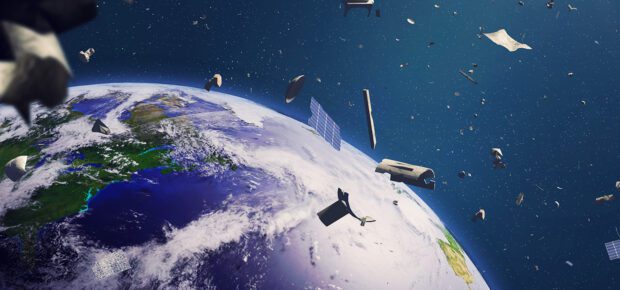April 27, 2023
Space is expansive. It’s also about to get more crowded. That has some concerned about the growing challenges of in-orbit traffic management and space debris – the pieces of space “junk” that revolve around the planet at speeds faster than a bullet.
Just a decade ago, approximately 1,200 satellites orbited the planet. Today there are at least 7,000. Thousands more are coming because several large companies have pledged to launch their own constellations – or networks – of communication satellites. Deloitte estimates that if every organization currently planning to build a constellation succeeds, up to 10 competing networks could be operational by 2030, with a total of 40,000-50,000 satellites.
In addition to working satellites, there are thousands of decommissioned satellites and rocket bodies in space. And then there are the millions of fragments orbiting the planet – the result of disintegration of satellites or the collision of two satellites, something that is more likely to occur as the skies get more crowded. Launches of new spacecraft have even been scrubbed and delayed due to the possibility of a collision with space debris.
“Space debris removal is central for future safe exploration of outer space,” said Fernando Buarque de Lima Neto, IEEE Senior Member.
Traveling at more than nine miles per second – about 10 times faster than a bullet – even small pieces of debris carry significant impact. The European Space Agency estimates that there are more than 36,000 pieces of space junk larger than four inches, and tens of millions of pieces of debris smaller than that. Some space junk is tracked, but much of it is not.

Globally, there is a significant research effort focused on the removal of space junk. Here are some of the latest efforts.
Space Tugs: One emerging capability in space is the use of space tugs (as in tugboats) to move satellites from one orbit to another, extending the lifetimes of out-of-fuel satellites that would otherwise be defunct. Space tugs can also tow pieces of debris toward where the debris would burn up during a controlled reentry into the earth’s atmosphere.
Lasers: There are hundreds of thousands of pieces of debris ranging from 1-10 cm. If two of them collide – or if they collide with a larger object – the impact could create thousands of new pieces of space garbage. Some researchers have suggested using lasers for the task. Rather than destroy the junk, the laser would simply nudge the trash out of the way.
Recycling: Launching assets into space is expensive. But future human settlements – including lunar bases – may need raw materials.
“Several startups are already looking at ways to monetize existing orbital debris for remanufacturing,” said IEEE Fellow Panagiotis Tsiotras. “Additionally, there are opportunities offered by an envisioned human settlement of a permanent lunar base.”
One possibility being explored now turns the aluminum found in most satellites into a solid state propellant that can be used for fuel – potentially to refuel other satellites or to use as fuel for the controlled reentry of larger objects
Of course, the easiest way to manage space trash is to prevent its creation in the first place. Under a new rule proposed by the U.S. Federal Communications Commission, satellites would have to deorbit five years after they stop working.
“Each day is more difficult to find a secure window for launching, and technology to recover or deorbit all this junk is a point of concern,” said IEEE Senior Member Antonio Pedro Timoszczuk.
Learn more: IEEE members have been driving breakthroughs since the dawn of space exploration. The IEEE Aerospace and Electronic Systems Society celebrated its 50th anniversary in 2023!





 The Impact of Technology in 2025
The Impact of Technology in 2025 Quantum and AI: Safeguards or Threats to Cybersecurity?
Quantum and AI: Safeguards or Threats to Cybersecurity? Why AI Can't Live Without Us
Why AI Can't Live Without Us Bits, Bytes, Buildings and Bridges: Digital-Driven Infrastructure
Bits, Bytes, Buildings and Bridges: Digital-Driven Infrastructure Impact of Technology in 2024
Impact of Technology in 2024 Emerging AI Cybersecurity Challenges and Solutions
Emerging AI Cybersecurity Challenges and Solutions The Skies are Unlimited
The Skies are Unlimited Smart Cities 2030: How Tech is Reshaping Urbanscapes
Smart Cities 2030: How Tech is Reshaping Urbanscapes Impact of Technology 2023
Impact of Technology 2023 Cybersecurity for Life-Changing Innovations
Cybersecurity for Life-Changing Innovations Smarter Wearables Healthier Life
Smarter Wearables Healthier Life Infrastructure In Motion
Infrastructure In Motion The Impact of Tech in 2022 and Beyond
The Impact of Tech in 2022 and Beyond Cybersecurity, Technology and Protecting Our World
Cybersecurity, Technology and Protecting Our World How Technology Helps us Understand Our Health and Wellness
How Technology Helps us Understand Our Health and Wellness The Resilience of Humanity
The Resilience of Humanity Harnessing and Sustaining our Natural Resources
Harnessing and Sustaining our Natural Resources Creating Healthy Spaces Through Technology
Creating Healthy Spaces Through Technology Exceptional Infrastructure Challenges, Technology and Humanity
Exceptional Infrastructure Challenges, Technology and Humanity The Global Impact of IEEE's 802 Standards
The Global Impact of IEEE's 802 Standards Scenes of our Cyber Lives: The Security Threats and Technology Solutions Protecting Us
Scenes of our Cyber Lives: The Security Threats and Technology Solutions Protecting Us How Millennial Parents are Embracing Health and Wellness Technologies for Their Generation Alpha Kids
How Millennial Parents are Embracing Health and Wellness Technologies for Their Generation Alpha Kids Space Exploration, Technology and Our Lives
Space Exploration, Technology and Our Lives Global Innovation and the Environment
Global Innovation and the Environment How Technology, Privacy and Security are Changing Each Other (And Us)
How Technology, Privacy and Security are Changing Each Other (And Us) Find us in booth 31506, LVCC South Hall 3 and experience the Technology Moon Walk
Find us in booth 31506, LVCC South Hall 3 and experience the Technology Moon Walk Virtual and Mixed Reality
Virtual and Mixed Reality How Robots are Improving our Health
How Robots are Improving our Health IEEE Experts and the Robots They are Teaching
IEEE Experts and the Robots They are Teaching See how millennial parents around the world see AI impacting the lives of their tech-infused offspring
See how millennial parents around the world see AI impacting the lives of their tech-infused offspring Take the journey from farm to table and learn how IoT will help us reach the rising demand for food production
Take the journey from farm to table and learn how IoT will help us reach the rising demand for food production Watch technical experts discuss the latest cyber threats
Watch technical experts discuss the latest cyber threats Explore how researchers, teachers, explorers, healthcare and medical professionals use immersive technologies
Explore how researchers, teachers, explorers, healthcare and medical professionals use immersive technologies Follow the timeline to see how Generation AI will be impacted by technology
Follow the timeline to see how Generation AI will be impacted by technology Learn how your IoT data can be used by experiencing a day in a connected life
Learn how your IoT data can be used by experiencing a day in a connected life Listen to technical experts discuss the biggest security threats today
Listen to technical experts discuss the biggest security threats today See how tech has influenced and evolved with the Games
See how tech has influenced and evolved with the Games Enter our virtual home to explore the IoT (Internet of Things) technologies
Enter our virtual home to explore the IoT (Internet of Things) technologies Explore an interactive map showcasing exciting innovations in robotics
Explore an interactive map showcasing exciting innovations in robotics Interactively explore A.I. in recent Hollywood movies
Interactively explore A.I. in recent Hollywood movies Get immersed in technologies that will improve patients' lives
Get immersed in technologies that will improve patients' lives